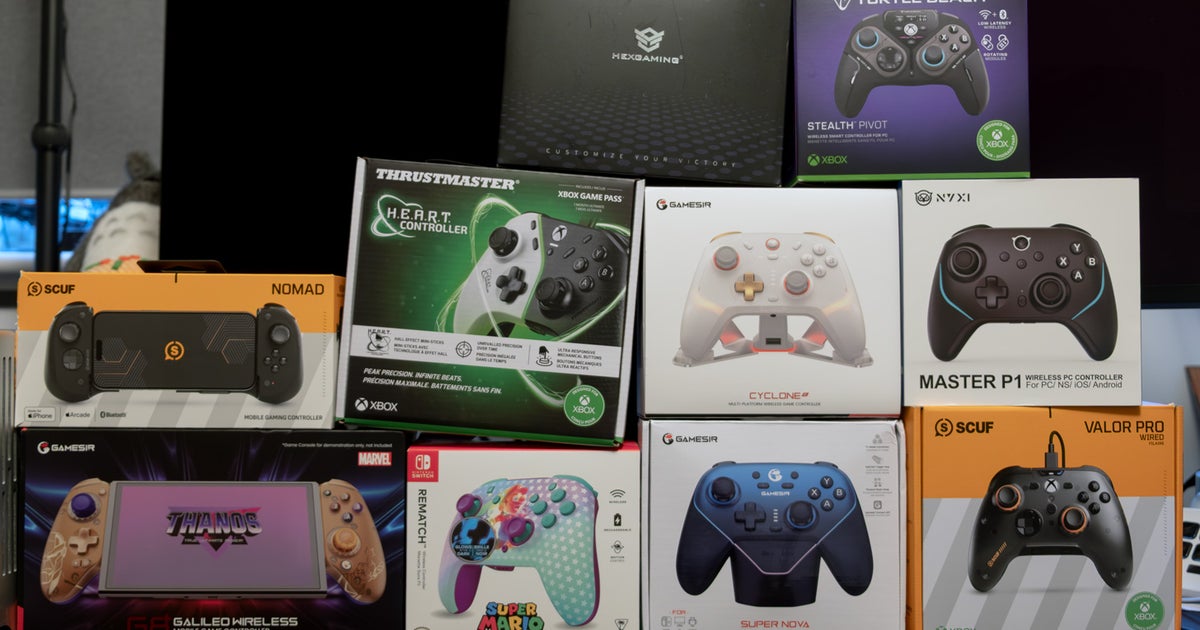2025 is the year of the Hall Effect (HE) gamepad, with pretty much every new model sporting this new tech in its sticks or triggers, promising an end to stick drift in favour of longer-lasting, more precise controls. Despite that convergence around a new standard, it’s also a year for innovation in terms of design, with tried-and-tested layouts sitting alongside some interesting experimental redesigns and more daring colourways.
To show off the state of the current controller market, we’ve written reviews for 10 recent releases, from major players like Scuf, Thrustmaster and Turtle Beach to emerging names like GameSir, HexGaming and Nyxi. Eight come with Hall Effect sticks, one comes with next-gen TMR sticks and just one – a budget Nintendo offering – features traditional potentiometer-based controls.
The vast majority are PC controllers, but most also work on at least one other platform – including one PS5 option, a small assortment of Xbox models and a fair few that add on Switch and/or mobile support. Maybe your next gamepad lurks within this round-up – you’d better read it to find out!
- HexGaming Phantom Pro (HE Explorer Edition): a feature-rich upgraded PS5 DualSense
- GameSir Super Nova: a great value controller with a sweet dock
- GameSir Cyclone 2: a brilliant demo of next-gen TMR stick tech at a killer price
- Scuf Valor Pro: an esports-focused wired Xbox/PC gamepad
- Thrustmaster Heart Controller: another Xbox pick with great software, silly branding
- Turtle Beach Stealth Pivot: an amazing rotating controller with two built-in button layouts
- Nyxi Master P1: a solid HE controller, nonetheless eclipsed by GameSir’s offerings
- Turtle Beach Rematch Wireless: a glow-in-the-dark Switch Pro Controller alternative
- GameSir G8 Plus (Thanos Edition): a high-end backbone-style Switch controller
- Scuf Nomad: a sleeker, iOS-only backbone-style gamepad
HexGaming Phantom Pro Hall Effect Explorer Edition
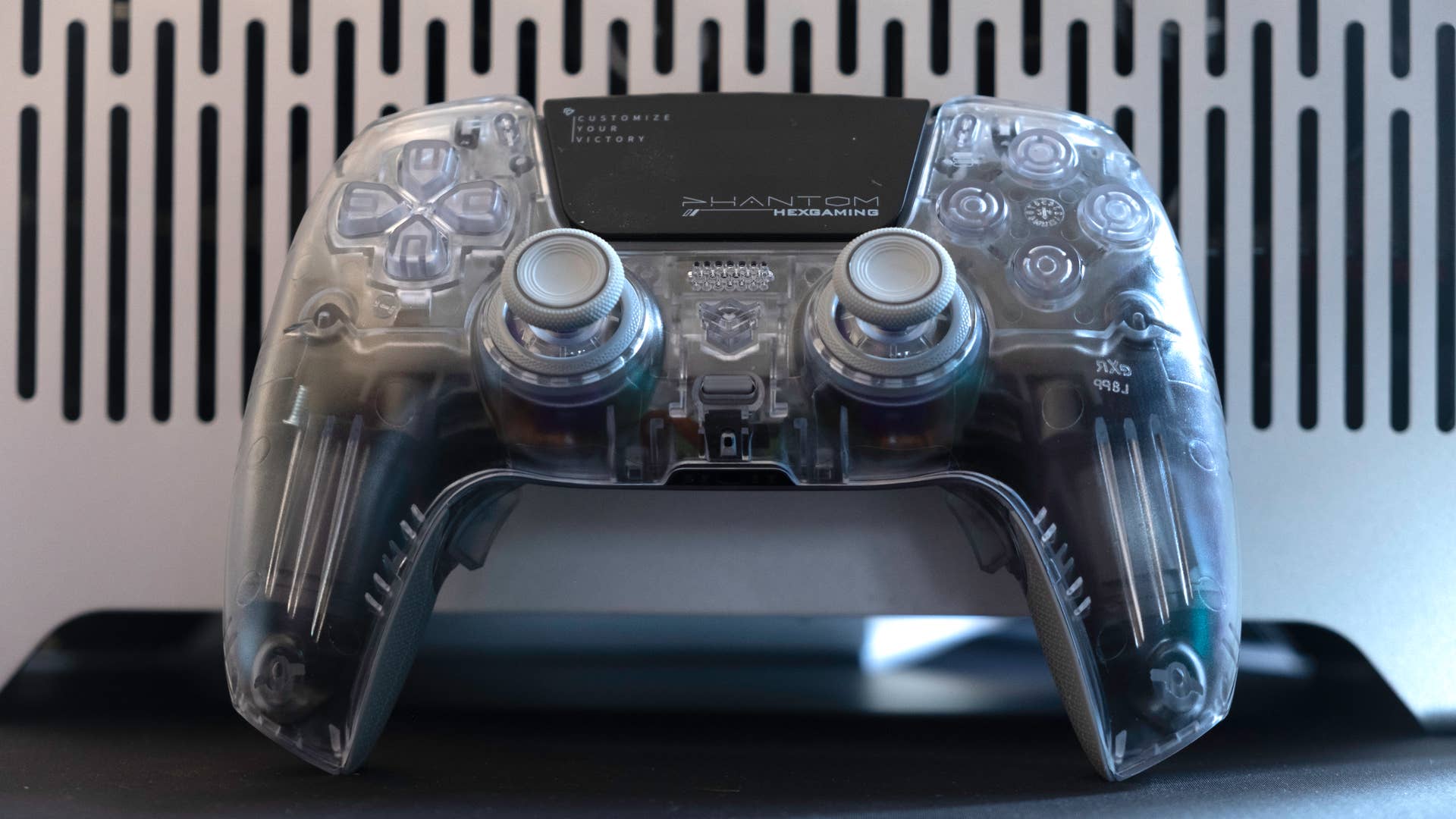
- In short: Upgraded PS5 DualSense controller with a transparent body and extra features
- Specs: 2.4GHz Wireless, Bluetooth, Wired, PC/Switch/Mobile, 330g, 160x100x60mm
- Buy: Amazon UK, Amazon US, HexGears Store
The HexGaming Phantom Pro is a powerful but expensive upgraded DualSense controller, offering PS5 and PC compatibility, button remapping, adjustable triggers and stick swaps. We’ve tested upgraded DualSense models from the likes of Scuf and MegaModz, which come with similarly steep price tags but add some worthwhile options unserved in the PS5 market outside of Sony’s (admittedly less expensive) DualSense Edge, which Tom liked back in 2023.
The Explorer Edition we tested comes in a transparent chassis that lets you see the mechanical gubbins inside, with opaque colourways also available. It’s also worth noting that the controller is sold both with standard potentiometers and more durable Hall Effect sticks, which for me is a no-brainer ~$20 upgrade for anyone considering spending £200/$200+ on a gamepad.
I’m not sure the Phantom really does enough to justify itself against its competitors without the wide customisability of the Scuf Reflex Pro or MegaModz DualSense options linked above. You do get a neat accessory pack with the controller, which includes six extra thumb sticks, optional stick protector rings and a calibration tool that connects below the charging point via a ribbon cable to dial in each stick. There’s also a reasonably premium 10m braided USB-C to USB-A cable, in case you prefer a wired connection to the default Bluetooth. Elsewhere, it’s fairly standard fare – the adjustable triggers lock nicely for quick digital inputs, the four back buttons are sensibly placed exactly where your middle fingers are likely to rest and clicky to boot. It’s quite easy to remap buttons or change between different profiles on the fly, which is handy for games that don’t offer quite the right controller presets (or indeed, no presets at all).
The actual feel of using the controller is where the Phantom Pro falls down. The top three face buttons (Square, Triangle, Circle) felt fine if a little light, but the X button had almost zero travel when pressed. All four buttons were still recognised correctly, but the difference in feel was off-putting. (Hopefully this was just an issue with our unit, as other reviews don’t mention similar problems.) The rest of the gamepad didn’t feel like an improvement over a standard DualSense, but it performed without issues. Of course, the usual caveats for PC use apply – as some games work perfectly, and others require the use of third-party tools like DSX and DS4Windows.
Overall, I’d say the Scuf Reflex Pro and Sony DualSense Edge are better value options, but the Phantom Pro makes a decent argument for itself on the durability front thanks to those HE sticks and corresponding calibration tool.
GameSir Super Nova
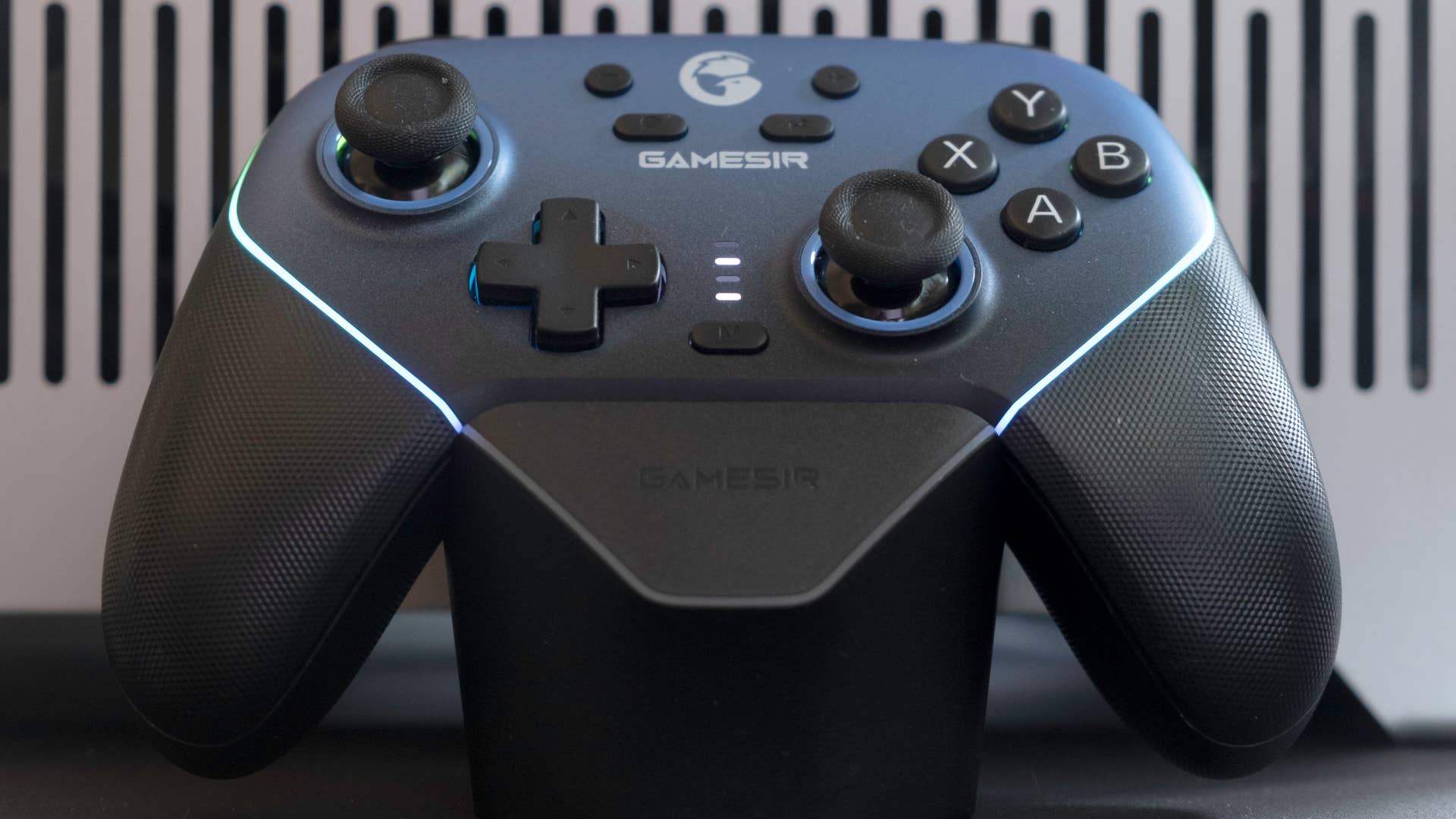
- In short: An affordable Hall Effect PC/mobile controller and dock
- Specs: 2.4GHz Wireless, Bluetooth, Wired, PC/Switch/Mobile, 263g, 156x106x59mm
- Buy: Amazon UK, Amazon US
The GameSir Super Nova is a very easy gamepad to recommend for PC and mobile gaming, as it matches the price of an Xbox Series controller while offering some key improvements: Hall Effect sticks and triggers, two programmable back buttons, a hair trigger mode and three connection methods at up to 1000Hz (via wired/2.4GHz wireless). Battery life is only average at ~15 hours, but that’s the only real limitation here – and one that’s effectively mitigated by the inclusion of a magnetic charging dock.
There are also some good cosmetic touches, with optional RGB lighting that connects the dock and the controller, and magnetic face plates to customise how the Super Nova looks. The Nightfall Blue colourway we were sent is quite fetching, with a pleasantly glossy gradient from lighter to darker shades of blue, and the rubberised grips on the lower edges of the gamepad are comfortable if not the absolute grippiest I’ve ever experienced.
The Super Nova acquitted itself well in Forza Motorsport on PC and Fire Emblem Engage on Switch; Android and iOS are also supported. The membrane face buttons worked consistently with a good amount of feedback and little clatter, the Hall Effect sticks felt responsive and the rumble provided good information about how the car was gripping the circuit when playing Forza. The rear paddle-style buttons are comfortable to reach too. Remapping buttons and changing other settings was straightforward with the GameSir Connect app on PC (Android and iOS apps are also available), which offers extremely granular control over various parameters. You can even swap the face buttons to suit the Nintendo layout, which is a nice touch.
At its £50/$50 asking price – as of the time of writing – the Super Nova is a genuine bargain and well worth considering for gamers that primarily play on PC, Switch and/or mobile. It’s performant, well-made and has all the features I look for in a great third-party PC controller in 2025.
GameSir Cyclone 2
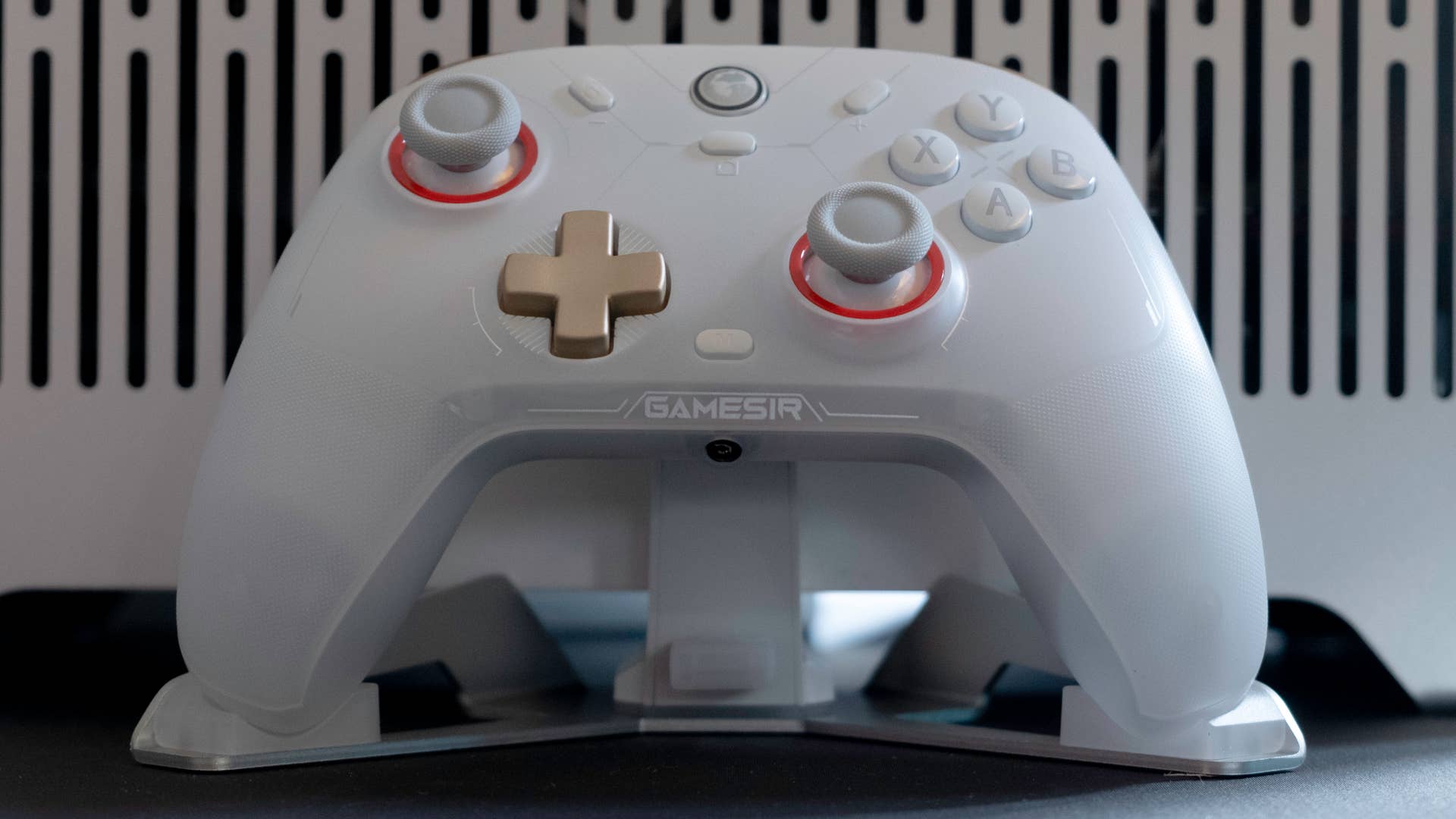
- In short: An early showcase of TMR sticks with clickier buttons
- Specs: 2.4GHz Wireless, Bluetooth, Wired, PC/Switch/Mobile, 228g, 156x103x63mm
- Buy: Amazon UK, Amazon US
Magnetic Hall Effect sticks are firmly mainstream now, but the next evolution is already being deployed: TMR or “tunnel magnetoresistance” sticks. These sticks are purported to offer better precision and power efficiency than Hall Effect sticks, while holding the same durability advantage over traditional potentiometer-based alternatives. The first model I’ve tested with TMR sticks is the GameSir Cyclone 2, and it’s a promising early taste of the technology.
The Cyclone 2 costs just £5/$5 more than the Super Nova we covered above, and besides the TMR sticks it offers similar features: an included magnetic charging dock, Hall Effect triggers, programmable rear buttons, RGB lighting and a 1000Hz polling rate via 2.4GHz wireless. PC, Switch, iOS and Android are supported, just like the Super Nova. However, there’s no sign of magnetic face plates here, just an RGB glow that filters through the semi-transparent shell.
Overall, the TMR sticks do seem to have a heavier feeling similar to potentiometer-based traditional sticks, and I couldn’t notice any difference in accuracy versus Hall Effect alternatives. Given their theoretically superior durability (ie less potential for stick drift over time), these new sensors could be worth adopting at some point sooner rather than later. (Of course, individual implementations matter just as much as the underlying tech, and TMR is much less mature technology in general.) I also liked the clicky d-pad and face buttons on the Cyclone 2 versus the quieter Super Nova.
If you want to get onto the TMR train then, the Cyclone 2 feels like a solid choice that otherwise has many of the same benefits and features of the Super Nova, including the same powerful GameSir Connect software.
Scuf Valor Pro
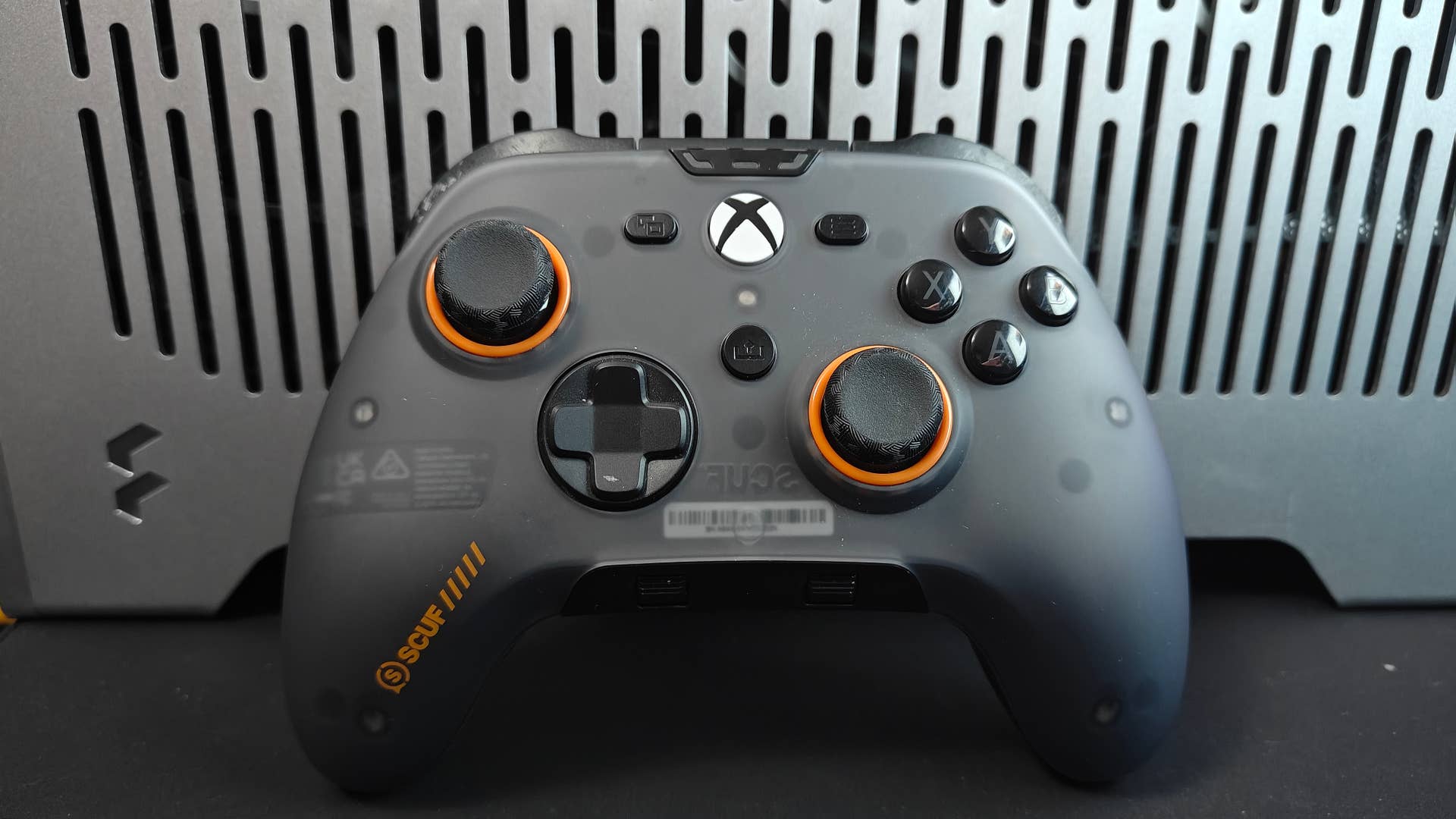
- In short: An esports-focused wired gamepad for Xbox and PC
- Specs: Wired, Xbox/PC, 260g, 153x107x64mm
- Buy: Amazon UK, Amazon US
The Scuf Valor Pro is a good option if you want high-end features from an established name, but you’d rather save a bit of money by going with a wired option over wireless. The Valor Pro is still a premium Xbox and PC controller, with high-end materials, Hall Effect sticks (a first for Scuf), optional hair triggers and four customisable rear paddles, but the focus here is very much on performance.
The Valor Pro doesn’t make any radical departures when it comes to design, with a familiar Xbox style layout that’s slightly smaller than the Elite Series 2. However, you’ll note some extra elements: a semi-transparent magnetic face plate for visual customisation, scroll wheels near the audio jack for easy volume/mix control and a soft touch exterior which is immediately comfortable to hold.
In-game, the Scuf Valor Pro is the best controller I’ve used for Call of Duty, with the rear paddles expertly placed and easy to differentiate by feel – one pair is clicky, while the other is soft. (You can disable the clicky inner pair with blanking plates if you prefer, too.) The thumb sticks feel responsive, with a stronger centring force than your average HE stick, and there are two alternative thumb sticks in the box to play around with. The clicky hair triggers provide more rapid inputs and nice tactile/aural feedback. The wraparound bumpers took some getting used to, but do minimise finger movement with some grip styles so I dig it.
The only issue I encountered was enabling the 1000Hz polling rate on PC, which is a bit byzantine as the Valor Pro isn’t integrated into Corsair’s iCUE software like the Scuf Envision. That was a little surprising for me, even for an Xbox-focused product, as I find remapping keys and making other adjustments way easier with a software interface. The “Valor Updater” app is somewhat less reliable, and it took me several attempts to update successfully – critically, you need to run two .exe files in succession to update the firmware, and both seem to require admin mode on Windows 11. For other tasks like remapping the rear paddles, you’ll be referring to the manual until you’ve got down the necessary button combos.
Playing on a mouse and keyboard is still a lot more natural for me, but I feel like my skill ceiling is just a little higher on the Valor Pro versus most of the other controllers on this list. Of course, you’re also able to use the extra buttons and responsive controls in other genres, and I had a blast racing a Lexus RC F around Watkins Glen in Forza Motorsport too. Overall, well worth considering if Xbox is your console platform of choice or you just want a great wired PC controller.
Thrustmaster Heart Controller
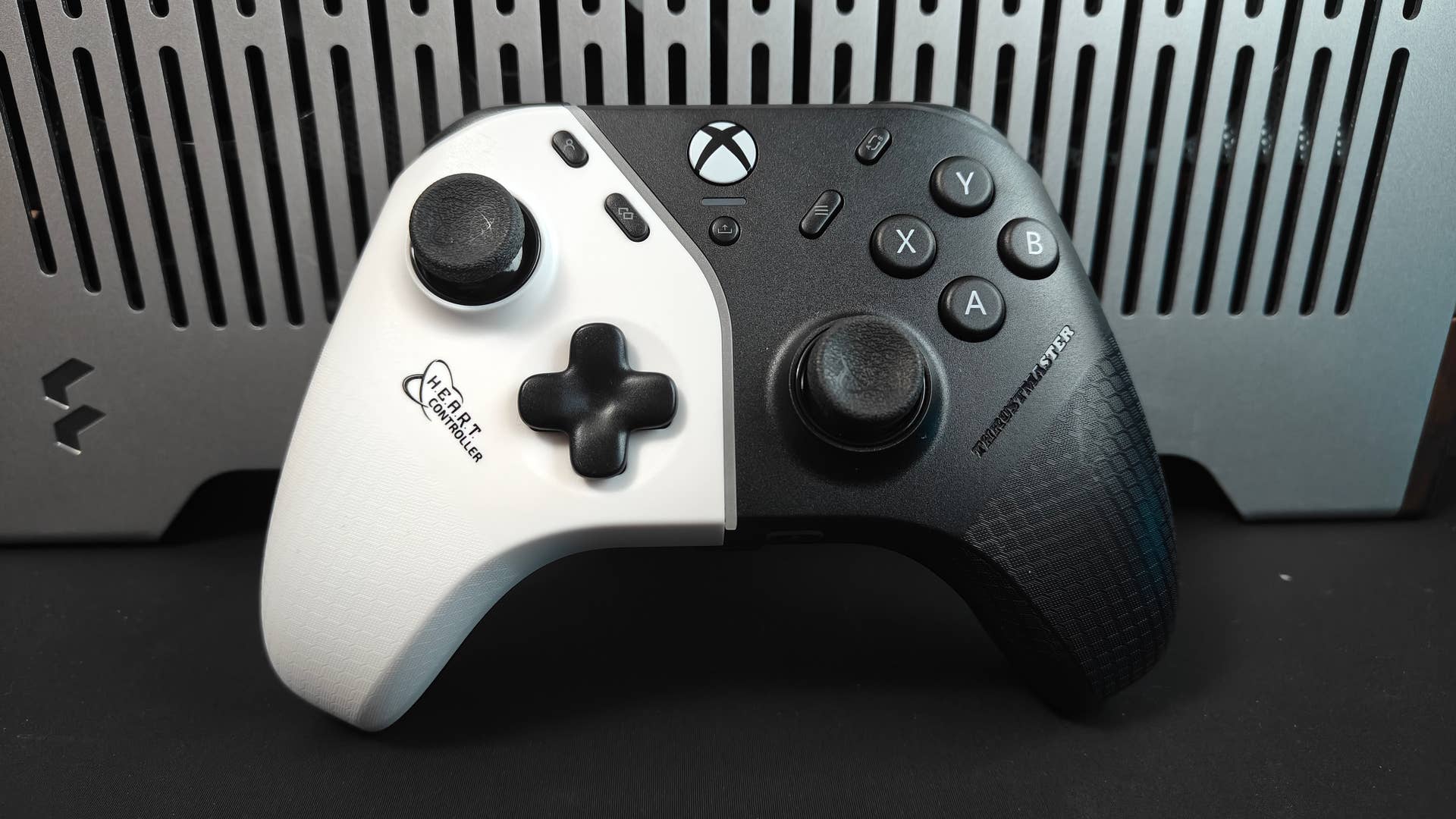
- In short: An alternative wired Xbox-focused controller pick with good companion software
- Specs: Wired, Xbox/PC, 214g, 160x110x45mm
- Buy: Amazon UK, Amazon US
The Thrustmaster Heart Controller has a weird name, but the French company just means that the gamepad features Hall Effect sticks that will resist drift. That’s maybe not enough to justify the Fallout-style “H.E.A.R.T.” branding that stands out on the left flank of the controller, but if it results in a reliable controller I guess it’s OK. Otherwise, the Heart differentiates itself with mechanical face buttons and d-pad – with a short throw of only 0.3mm – and two remappable buttons on the back of the wired-only gamepad.
There’s also a strangely bright asymmetric RGB strip that divides the Heart into white and black zones, which you can dim and change between six colours by holding down the profile button and then using the d-pad. Weirdly, you can’t change the lighting in the ThrustMapperX software, but you can adjust stick sensitivity and dead zones, remap buttons and update the firmware. After being frustrated by the lack of software with the Scuf Valor Pro, this was nice to see. You can also remap the rear buttons using the controller itself if you don’t have access to a PC.
I feel a bit ambivalent about the Heart after testing it in my usual assortment of RPGs, racing games and FPS titles. For racing, I found it a good performer, comfortable to hold and befitting its ~£100 RRP. In RPGs though, I found the d-pad’s short travel extremely infuriating, as it felt way too easy to select the incorrect options when moving through an inventory screen or selecting attack targets. (The Start/Select buttons are also quite minute, making them difficult to press reliably too.) I had a similar issue in FPS titles, though here you’ll likely be hitting the d-pad less frequently.
For what it’s worth, I still recommend giving the Heart a go if you want an Xbox and PC controller that is easy to reconfigure using software. I’m sure I could learn to accept the d-pad and start/select designs, and the rest of the controller feels well-considered and well-built.
Turtle Beach Stealth Pivot
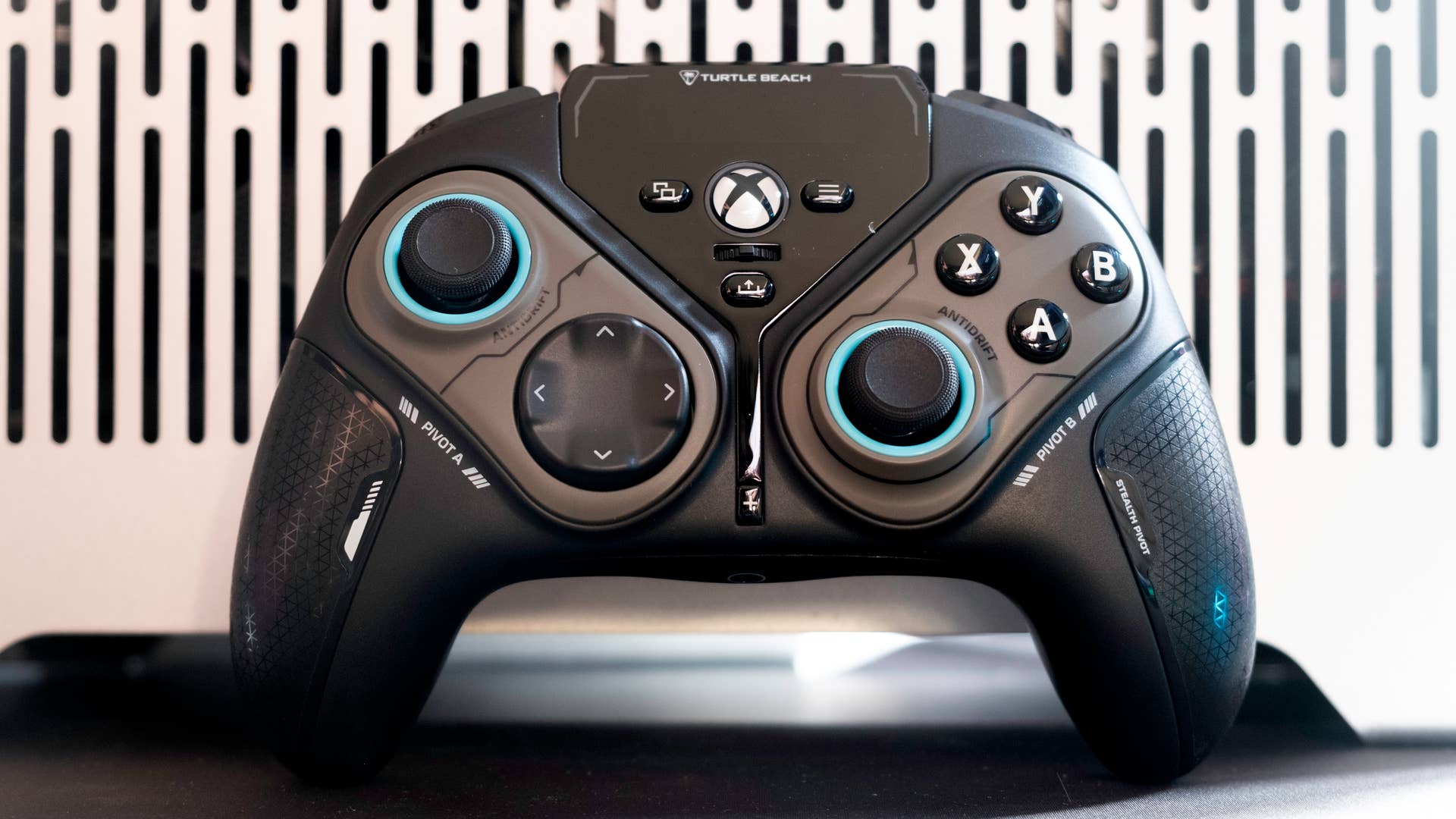
- In short: An amazing rotating wireless controller with two built-in button layouts
- Specs: 2.4GHz wireless, Bluetooth, Wired, Xbox/PC/Switch/Mobile, 301g, 161x108x67mm
- Buy: Amazon UK, Amazon US
“Ready to pivot” is one of the phrases that Rich likes to pepper in our Patreon updates to describe our readiness to change plans to cover the news of the day, so Turtle Beach’s Stealth Pivot tickled me before I even got it out of the box. I was even more amused when I realised that the default arrangement of sticks, d-pad and face buttons can rotate out of the way to reveal a fighting-style layout with a d-pad and two face buttons on the left, and six further face buttons on the right.
The process is extremely smooth and takes just a second or two, though you do have to rotate each thumbstick, minimising its height to allow the rotation to take place. There are also locks for each side on the underside of the controller to prevent any accidental rotations during gameplay. It’s a surprisingly useful inclusion for fighting game fans, and as a controller-based party trick it’s unmatched.
Elsewhere, the Stealth Pivot resembles the Stealth Ultra, with an integrated one-inch LCD screen near the top of the unit, allowing for more intuitive changes to the controls and settings, optional hair triggers, Hall Effect sticks, two programmable rear buttons, a programmable volume dial, 3.5mm jack and compatibility with PC and mobile (2.4GHz, Bluetooth or wired) plus Xbox (wired only). There’s also a good software package on Windows, Xbox and mobile (Turtle Beach Control Center 2) for making changes if you prefer.
The controller feels well-made and doesn’t feel as bulky as you’d expect given the rotating button arrangement, though it is one of the heavier designs on this list. It also performs well in-game, with reasonably tactile membrane face buttons, precise sticks and a comfortable layout, though the rumble here is a bit underwhelming. Hopping into Soul Calibur 6, the fight-stick mode impressed as much as you’d hope, with an excellent d-pad and much more convenient access to the left/right shoulder buttons and the programmable P1/P2 buttons.
Overall, an awesome option for fighting game fans that want a single high-end controller to play a wide range of genres.
Nyxi Master P1
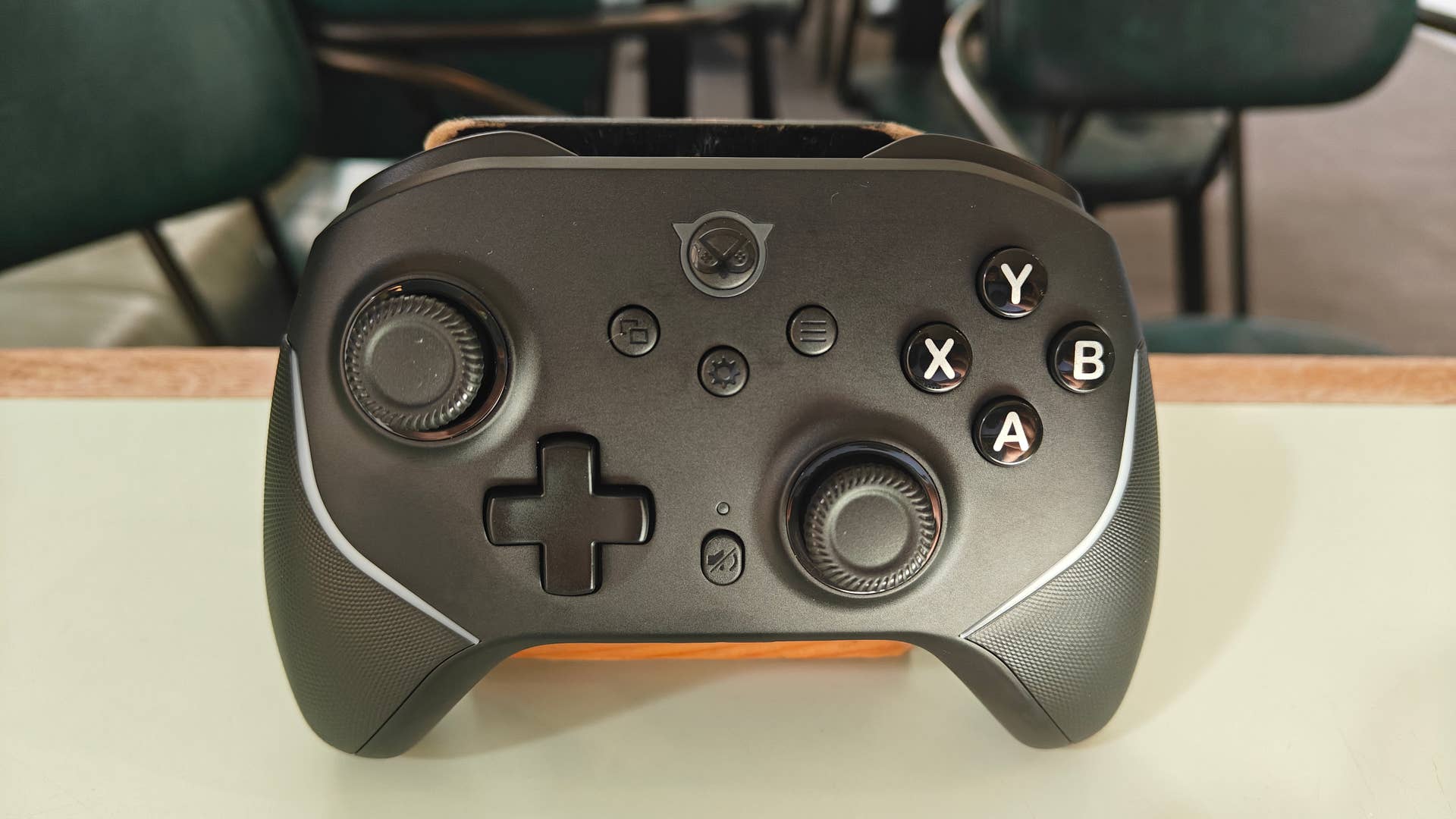
- In short: An affordable wireless Hall Effect option
- Specs: 2.4GHz wireless, Bluetooth, Wired, PC/Switch/Mobile, 230g, 152x106x62mm
- Buy: Amazon UK, Amazon US
The Nyxi Master P1 occupies similar territory to the GameSir Super Nova, with an Xbox-style design, Hall Effect sticks and triggers, optional clicky hair triggers, a clicky d-pad and two lockable and programmable rear buttons. The controller feels robust enough in the hand, despite its plastic construction, but takes a step backwards versus the Super Nova in terms of design with slightly less refined button legends and a simpler monochrome design with no swappable face plates. There is a line of RGB separating the (adequate) grips from the rest of the (relatively slick) body, in the style of the Razer Wolverine V2 Chroma.
Testing the P1 via Bluetooth on a Mac, the controller showed up as an “Xbox One S” model, which is faintly amusing but probably sensible for compatibility. The core functionality worked easily out of the box, though the included media controls didn’t function in macOS.
The button layout here is very familiar, with more sensibly placed start/select buttons than on some other examples, decent membrane face buttons and rear buttons that line up perfectly with where I rest my middle fingers. Powering through some homebrew games, the clicky d-pad felt less problematic than on the Thrustmaster Heart, though the eight-way design on the similarly-priced standard Xbox controller feels a bit more robust. The hair trigger mode still requires a bit more travel than other controllers, which isn’t ideal for FPS, and the rumble here is the vaguest of any of the controllers on this list to support it.
Of course, you are getting the more reliable Hall Effect sticks and triggers, so there is at least a longevity advantage over your standard potentiometer-based controllers – including the ones included with the PS5 and Xbox Series X/S. However, I’d still recommend the GameSir Super Nova or Cyclone 2 above, as they feel more precise, come with a magnetic charging dock and support the same platforms while costing around the same price. If the P1 is much cheaper in your region though, it could be a good shout.
Turtle Beach Rematch Wireless
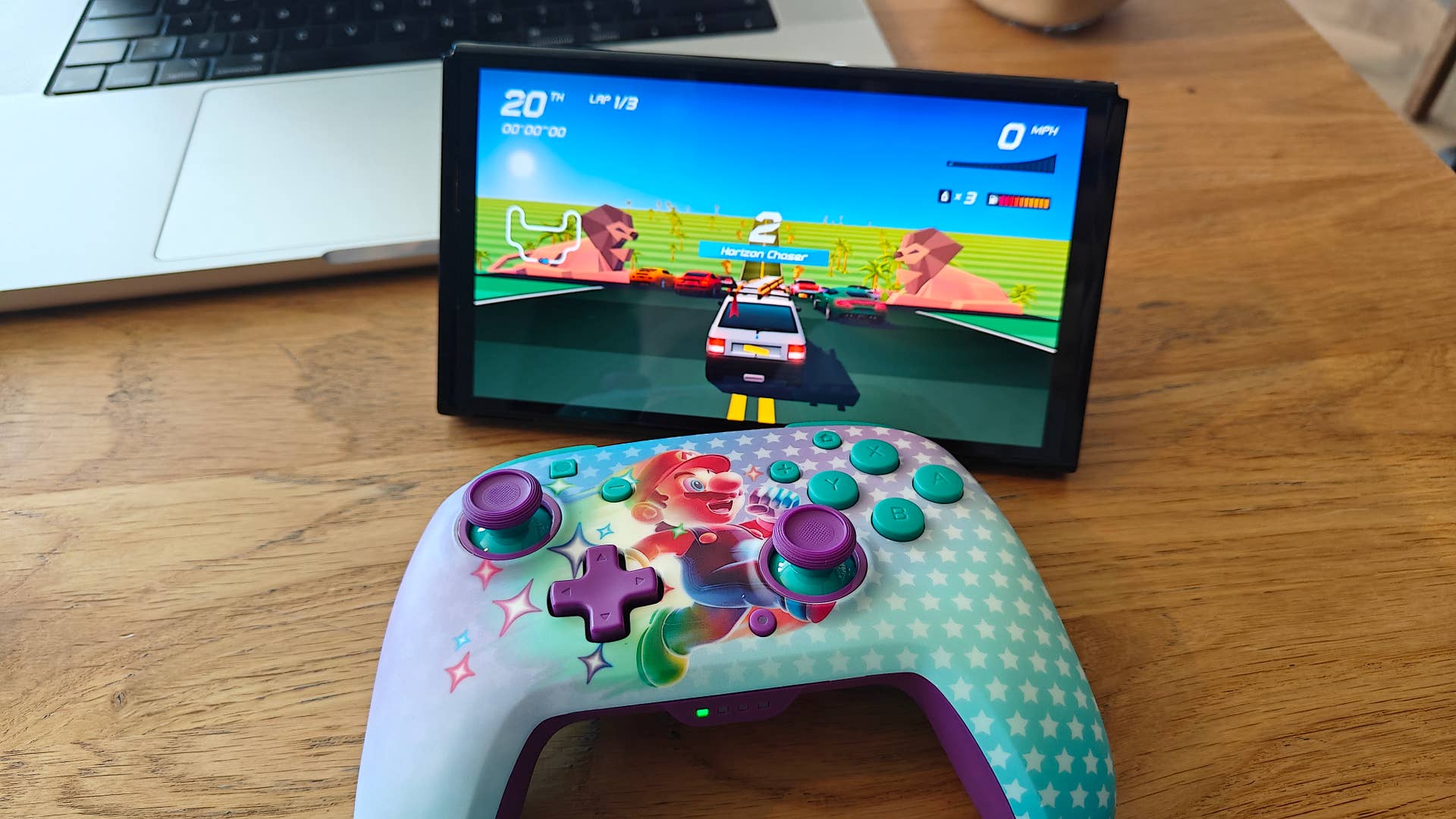
- In short: An affordable wireless alternative to Nintendo’s Pro Controller
- Specs: Bluetooth, Switch, 301g, 165x127x51mm
- Buy: Amazon UK, Amazon US
The Rematch Wireless is an interesting Switch (and presumably Switch 2) controller that sports glow-in-the-dark Mario designs, a lower price than the Switch 2 Pro Controller and even some proper “pro” features in the form of two remappable rear buttons. The controller only works on Switch – plugging it into a PC does nothing except charge the controller. That feels like a pretty arbitrary restriction, but given the kid-friendly design elements, it’s probably not one that’s likely to offend.
On Switch, I had a glorious time playing through a few stages in Horizon Chase Turbo, getting stuck in the opening levels of Doom 2 and winning the obligatory introductory bot game of Fortnite. The (potentiometer-based!) sticks feel a little light, but the membrane face buttons have a pleasant report, the d-pad is usable enough and the (digital, because Switch) triggers are short-throw and responsive.
Overall, there’s a sense of build and design quality that approaches that of the Pro controller, despite the all-plastic construction, and at around £20 cheaper than the Switch 2 model with the more eye-catching designs and extra buttons, that’s not a bad calculus.
GameSir G8 Plus (Thanos Edition)
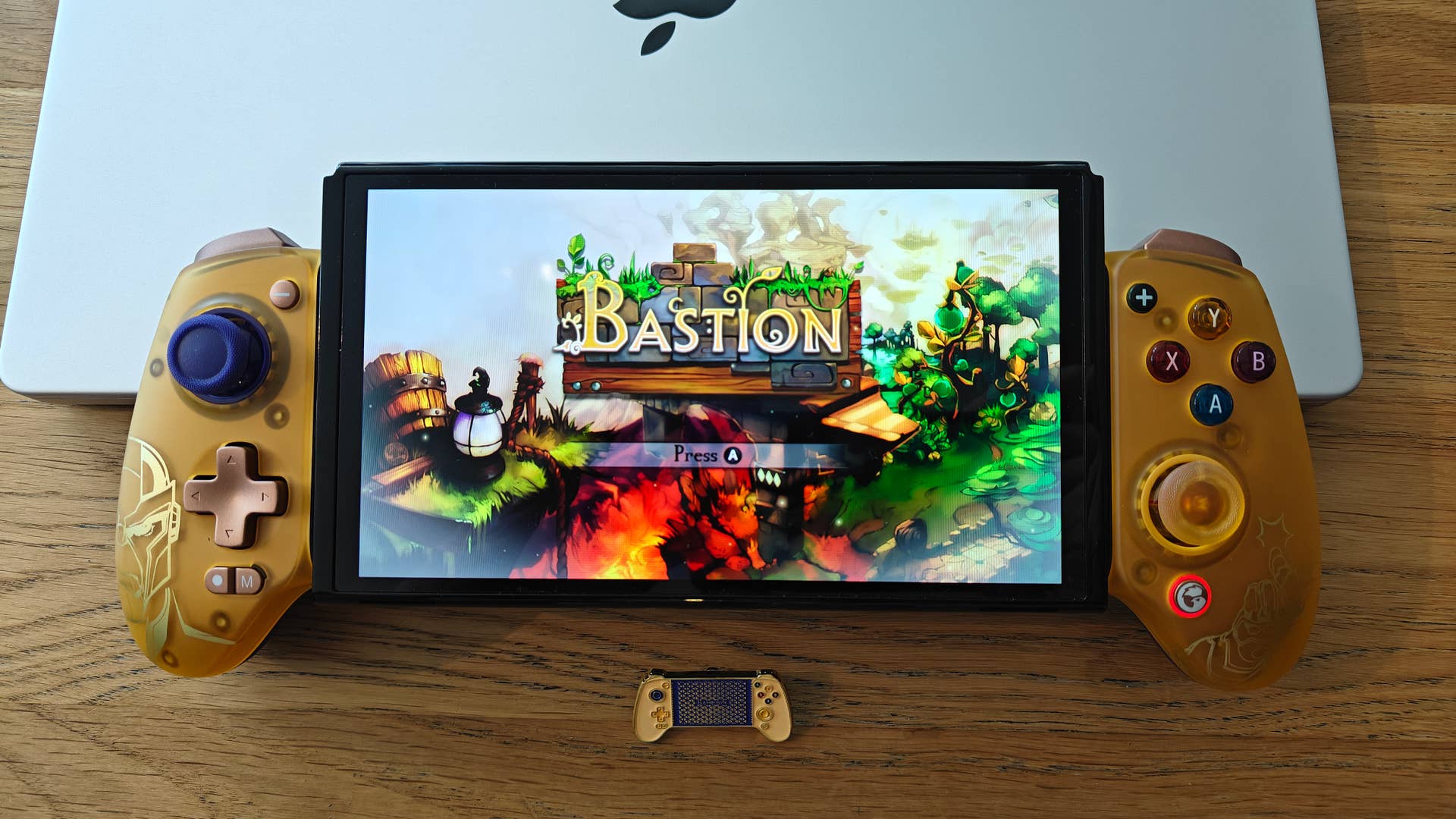
- In short: A high-quality backbone-style controller for Switch or mobile
- Specs: Bluetooth, Switch/Mobile/PC, 314g, 262x149x66mm
- Buy: Amazon UK, Amazon US
The GameSir G8 Plus, seen here in the gold-coloured Thanos Edition, is a backbone-style expanding controller that grows to envelop your Switch, mobile or tablets up to 215mm long. It’s also PC-compatible via Bluetooth or an optional 2.4GHz adapter sold separately, though the form factor doesn’t make a lick of sense here.
As you’d expect from a modern GameSir controller, it’s extremely well-built with responsive Hall Effect sticks and triggers, no hint of deck flex and a comfortable full-size Xbox-style layout. The Thanos edition looks incredible, with Infinity Stone coloured face buttons and gold/purple colours elsewhere, and you even get the villain’s face and famous snap on the grips. On the back, there are two extra buttons right where your middle fingers sit naturally. The only real limitation here is battery life, with a rated eight hours that doesn’t really compare to more traditional controller designs.
I played through a good amount of Supergiant Games’ original hit Bastion, which requires a decent amount of precision to avoid projectiles and trigger your attacks at just the right time. The G8 Plus felt comfortable throughout. You can also use a mobile app to remap keys, which I appreciated to make the Switch button prompts match the Xbox-style legends – alternatively, I could have taken off the magnetic top cover and physically re-arranged the face buttons to a Nintendo-style layout. Turbo mode and replacement sticks are also included.
If you mostly game on the go on Switch or mobile, this is a good value option that also looks fantastic in this special edition. The only real downside again is that battery life, so as long as you’re able to easily recharge via USB-C, this is a stand-out option and the best backbone-style controller I’ve tested.
Scuf Nomad
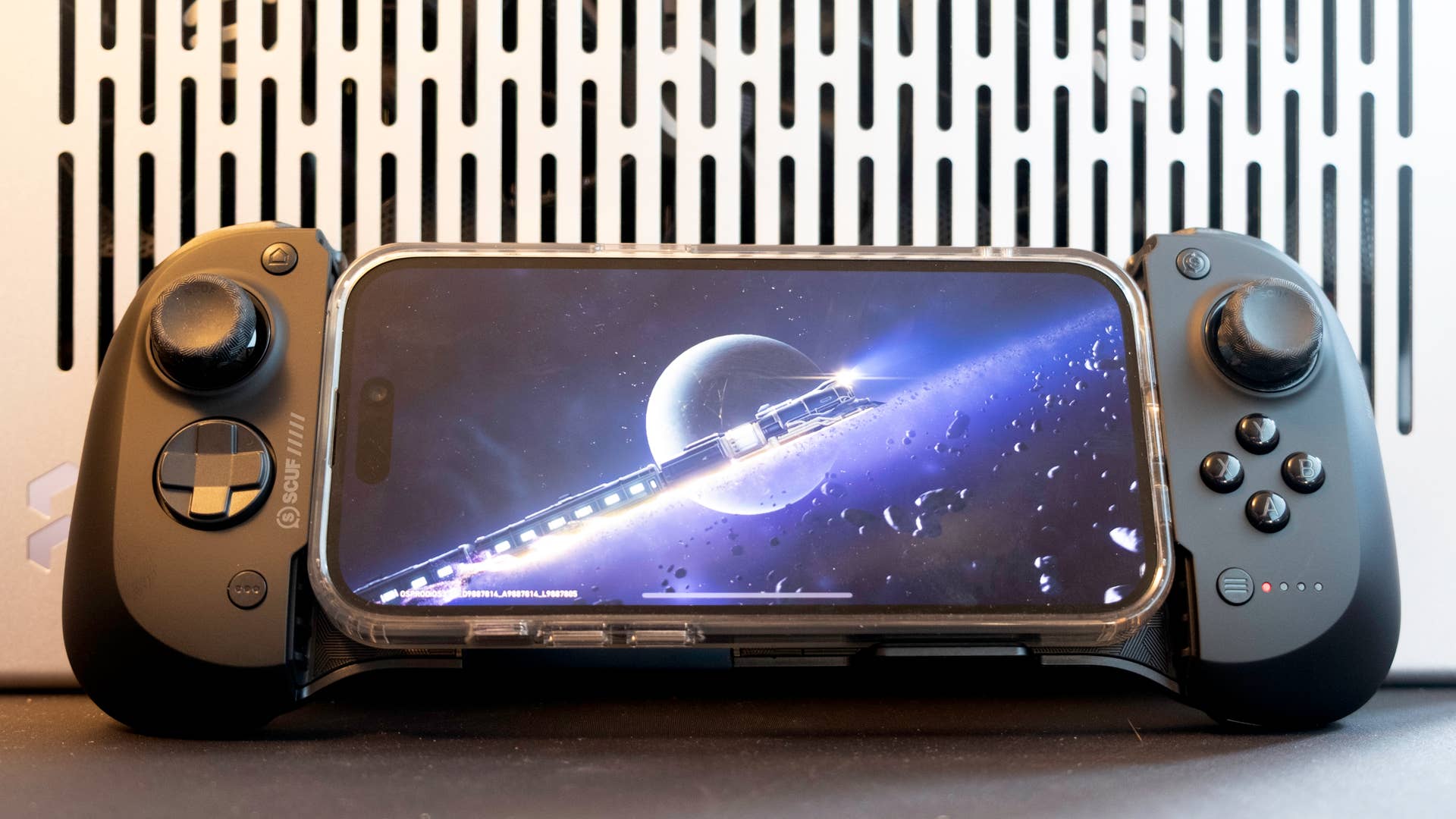
- In short: a sleeker iOS-only backbone-style controller
- Specs: Bluetooth, Mobile, 228g, 202x101x51mm
- Buy: Amazon UK, Amazon US
The Scuf Nomad is a streamlined, almost pocketable backbone-style controller for iPhone and iPad only – no Android or Switch support here.
The Nomad works well, prompting you to install Scuf’s specialised software when first paired, and thus allowing you access to an exhaustive settings menu and a (slightly dated) list of recommended controller-compatible games across the App Store, Apple Arcade and various streaming services. Galaxy on Fire 2 HD came out 13 years ago, so it has no concept of the holepunch screen of modern iPhones, but its arcade space combat still controls well on the Nomad. More modern fare, like Diablo Immortal and Honkai: Star Rail, offers better integration and more challenging scenarios to make full use of the high-quality membrane buttons, Hall Effect sticks and programmable rear paddles.
I did find that my phone sometimes slipped out from the Nomad – both with and without a case, once slamming my finger into the mechanism – but in general the industrial design here is sensible. The soft touch material is pleasant and grippy, charging and pairing is intuitive, and there are some useful extra keys to access the Nomad app or the home screen.
All in all, a polished experience for iPhone users that offers a massive step up in usability over touch-screen controls, but one that ought to work on Android too – and some slightly more up-to-date games to recommend in-app wouldn’t go amiss either.
Wrapping up
It’s been fascinating to test so many gamepads over a relatively short two-week period, and it’s clear that while some elements are becoming standard – like the Hall Effect sticks and triggers – there’s so much innovation elsewhere too. Different brands making significantly different bets in terms of features, designs, colours and materials, and the quality that you can get these days for £50 or £100 puts some first-party controllers to shame.
But what do you think of the round-up? Have any of these controllers caught your eye? Let me know in the poll and comments below! For more controller chat, check out our rankings of the best PC gamepads for 2025 too.
